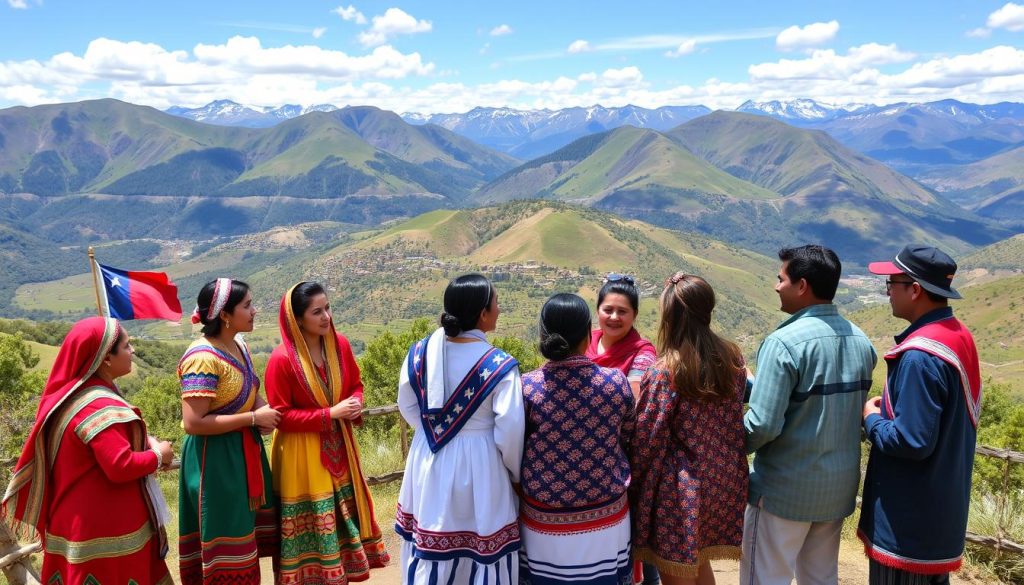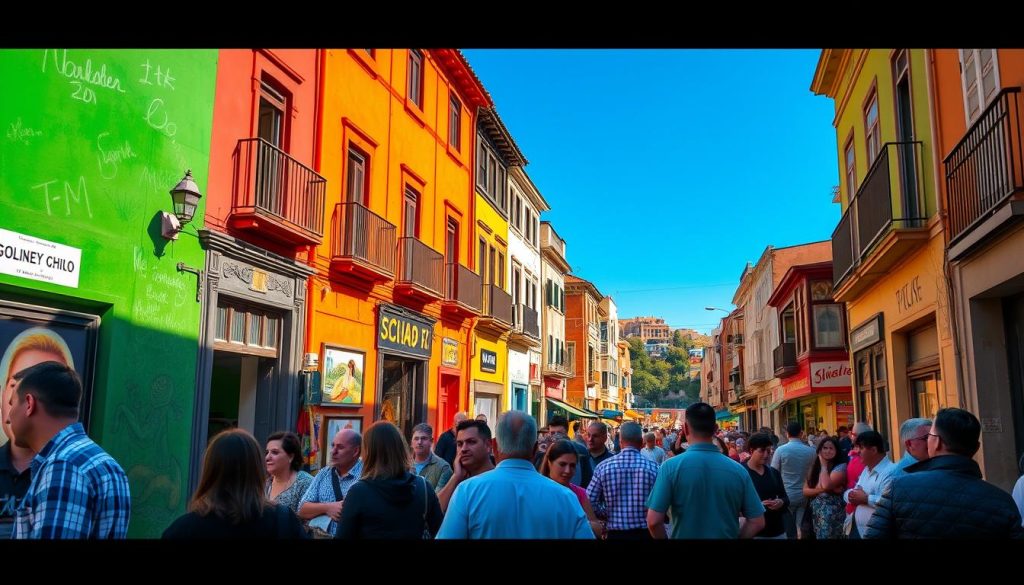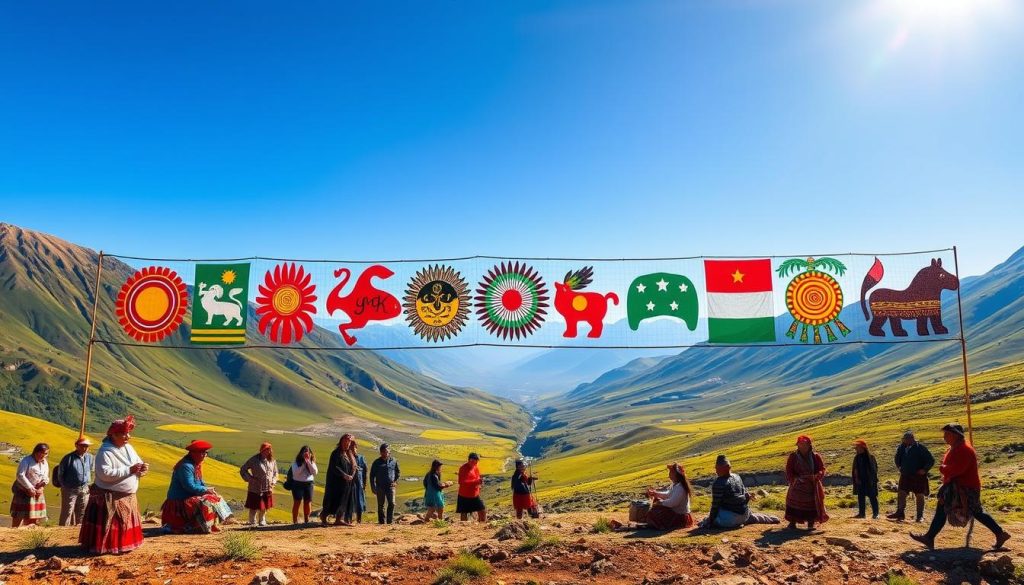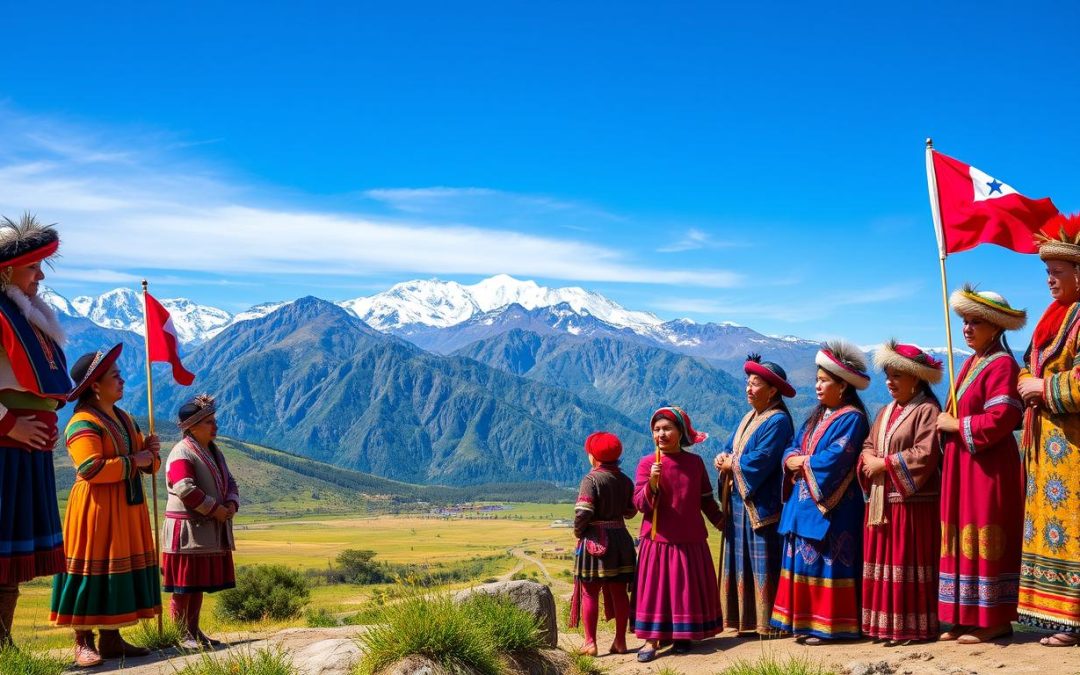Have you ever thought about how one country can have so many languages? Chile, a special country in South America, has a rich mix of languages. It’s more than just one main language.
In Chile, Spanish is the most common language, spoken by 99.3% of people. It’s the main way people talk to each other in this diverse land. But, there are also many other languages, showing the country’s rich culture.
Chile’s languages tell a story of its history and culture. From Patagonia to Easter Island, each area has its own language. Languages like Mapudungun, Aymara, and Rapa Nui mix with Spanish, showing Chile’s diverse identity.
Key Takeaways
- Spanish is the official language, spoken by 99.3% of Chileans
- Indigenous peoples represent 4.58% of the Chilean population
- Multiple indigenous languages are preserved and recognized
- Chile has at least 15 distinct linguistic dialects
- The country supports bilingual education programs
Overview of Language Diversity in Chile
Chile’s language scene is a colorful mix that shows its rich culture. Exploring the country’s languages, you see a complex mix of communication. This mix comes from history and cultural exchanges.

Most people in Chile speak Spanish, about 99%. Chilean Spanish is special because it has its own regional sounds. These sounds reflect Chile’s geography and culture.
Current Language Demographics
Chile’s language scene is a mix of many traditions:
- Spanish is the main language everywhere
- Indigenous languages are important for minority groups
- Mapudungun is key for the Mapuche people
- Aymara is spoken in northern Chile
Language Distribution Across Regions
Chile’s wide geography affects its languages. From the Atacama Desert to Patagonia, different groups have their own ways of speaking.
Historical Language Evolution
“Language is the roadmap of a culture. It tells you where its people come from and where they are going.” – Rita Mae Brown
Chile’s languages have changed over centuries. Indigenous tongues like Mapudungun and Quechua have kept their place. They show how minority languages keep cultural identity alive.
Looking into Chile’s language world, you see a place where diversity shapes identity and understanding.
Spanish as the De Facto Official Language

In Chile, Spanish is the main language used for official business, government, and social talks. A huge 99.3% of people speak Spanish. This makes Chile’s language scene lively, with a focus on its special Chilean Spanish.
The Spanish spoken in Chile, called Chilean Spanish, is quite different. It has its own special traits that make it stand out. This dialect shows the country’s rich culture, blending indigenous languages and history.
“Language is the road map of a culture. It tells you where its people come from and where they are going.” – Rita Mae Brown
Chilean Spanish is known for:
- Unique ways of pronouncing words
- Its own set of words
- Fast speech
- Strong influences from indigenous languages
Even though Spanish isn’t officially named as the main language, it’s the main way people talk. It’s used in:
- Government papers
- Schools
- Courts
- Media and shows
The Royal Spanish Academy sees Chilean Spanish as a key part of Spanish. They celebrate its special words and cultural touches.
Indigenous Languages and Their Status
Chile’s language scene is filled with indigenous tongues that show the country’s deep cultural roots. These languages are more than just ways to talk—they hold historical wisdom and cultural identity.

The indigenous languages of Chile show a complex mix of cultural diversity. Several key language groups stand out in the nation’s linguistic heritage:
- Mapudungun: Language of the Mapuche people
- Aymara: Spoken in northern Chilean regions
- Quechua: Representing Andean cultural traditions
- Rapa Nui: Polynesian language of Easter Island
Government Recognition and Protection
Chile has made big steps to keep indigenous languages alive. The Intercultural Bilingual Education Programme (PEIB) is a key part of this effort. It works to create educational plans that honor and support indigenous language rights.
Current Usage Statistics
Recent data shows how indigenous languages are doing in Chile:
- Mapudungun: About 258,410 speakers
- Aymara: Around 1,677,100 speakers in the region
- Quechua: Roughly 7,735,620 speakers across South America
“Language is the roadmap of a culture. It tells you where its people come from and where they are going.” – Rita Mae Brown
Despite the hurdles, indigenous languages are still key to Chile’s culture. The ongoing work to save these languages shows a strong commitment to Chile’s rich language diversity.
Mapudungun: The Language of the Mapuche People

Mapudungun is a key part of Chile’s indigenous languages and heritage. It has survived for centuries, linking the Mapuche people to their ancestors and identity.
The language’s current status shows both strength and weakness:
- Approximately 260,000 native speakers as of 2007
- Around 120,000 active speakers in Chile
- Only 16% of Mapuche people can speak the language fluently
Mapudungun’s use varies by location:
| Region | Speaker Percentage | Language Usage |
|---|---|---|
| Rural Areas | 16% | Use with children |
| Urban Areas | 2.4% | Use with children |
“Language is the roadmap of a culture. It tells you where its people come from and where they are going.” – Rita Mae Brown
Keeping Mapudungun alive is vital. The Bilingual Intercultural Education Programme (PEIB) offers weekly lessons. These focus on Indigenous language and culture, mainly in schools and preschools. The goal is to keep Mapudungun alive for the next generations.
Despite obstacles, the Mapuche people are dedicated to their language. They work hard to keep Mapudungun alive. This ensures it remains a vibrant part of their cultural identity.
Chile: Official and Widely Spoken Languages
Chile’s language scene is deeply connected to its rich culture and complex society. Knowing about the country’s language policies shows how communication, education, and work are linked.
Language Policies and Legislation
The Chilean government has set up detailed language policies. They make Spanish the main way people communicate. Key points include:
- Spanish as the official language in all government documents
- Constitutional recognition of linguistic diversity
- Protection of indigenous language rights
Educational System Language Requirements
Chile’s schools are key in keeping and growing languages. The curriculum focuses on:
- Spanish-medium instruction across all educational levels
- Bilingual programs in indigenous regions
- Foreign language education opportunities
Business and Professional Language Use
In Chile, how people talk at work shows the country’s language mix. Companies focus on:
| Language Sector | Professional Requirement |
|---|---|
| Corporate Communication | Spanish Proficiency |
| International Business | English Competency |
| Indigenous Regions | Bilingual Skills |
“Language is the roadmap of a culture. It tells you where its people come from and where they are going.” – Rita Mae Brown
Understanding Chile’s language policies, school needs, and work talk will help you get around the country’s lively culture.
Endangered and Extinct Indigenous Languages
Chile’s linguistic heritage is at risk, with many indigenous languages facing extinction. Around 1,500 languages worldwide are expected to disappear by 2100. Chile’s languages are among those at high risk.
Many indigenous languages have already stopped being spoken. Extinct languages in Chile include:
- Selk’nam
- Kakauhua
- Kunza
- Diaguita
“Language is the roadmap of a culture. It tells you where its people come from and where they are going.” – Rita Mae Brown
The Yagan language, once spoken in Tierra Del Fuego, is now lost. Its last fluent speaker, Cristina Calderon, died in 2022. This marked the end of a long tradition.
Chile knows the importance of saving endangered languages. Since 2017, schools with over 20% Indigenous students must teach their languages. For example, a school in Calama now teaches Ckunsa, showing efforts to revive languages.
The government is working hard to protect these languages. They are:
- Creating curriculum for Indigenous language and culture
- Supporting projects to document languages
- Encouraging Indigenous language education in schools
These efforts aim to keep Chile’s cultural heritage alive. They ensure the country’s rich culture stays connected to its roots.
Immigrant Languages in Chilean Society
Chile’s language scene is a colorful mix of immigrant tongues. These languages have deeply influenced the country’s cultural diversity. Waves of immigration from Europe and Asia have brought many languages, making Chile’s culture rich and varied.
European Language Communities
German immigrants have made a big impact on Chile’s language scene. About 150,000 to 200,000 Chileans have German roots, mostly in southern areas like Valdivia and Puerto Montt. They keep their language alive through cultural centers, schools, and community events.
- Cultural centers
- Local schools
- Community gatherings
Asian Language Communities
Asian languages have also added to Chile’s language mix. Korean and Chinese communities are big in cities like Santiago. They work hard to keep their languages alive, showing the lasting effect of immigrant languages on Chile.
| Immigrant Group | Primary Language | Estimated Population |
|---|---|---|
| German Descendants | German | 150,000-200,000 |
| Korean Community | Korean | 20,000-30,000 |
| Chinese Immigrants | Mandarin | 25,000-35,000 |
Impact on Chilean Culture
Immigrant languages have changed Chile in many ways. They’ve influenced food, customs, and traditions. Cultural integration happens through language exchange, making Chile’s identity rich and welcoming to all.
Language is the roadmap of a culture. It tells you where its people come from and where they are going. – Rita Mae Brown
English Proficiency and Foreign Language Education
Chile is working hard to improve its English skills. This effort shows the country’s focus on language diversity and education. Chile wants to compete globally, and English is key to this goal.
In 2019, a study by Education First Ltd. showed Chile’s English skills are at a medium level. This highlights both the challenges and chances in Chile’s language education. Many students find it hard to reach the B1 level of English proficiency.
“Learning English is increasingly essential in Chile’s competitive business environment, driven by international trade and economic activities.”
Key Insights into English Proficiency
- English became compulsory in schools in 1998
- Minimum of three hours of English instruction per week
- English Open Doors Program (EODP) supports language development
- Primary goal: Students achieve B1 level before tertiary education
Language Education Landscape
| Aspect | Statistics |
|---|---|
| Parental Support | 93% support English for improved opportunities |
| Corporate Training | 30% of companies provide English training |
| Management Skills | 48% of employers consider English crucial |
The English skills in Chile vary by region and social class. Cities tend to have better English skills. Schools are working to teach English in a way that meets global needs.
Chile is dedicated to improving its English skills. This will help its people connect with the world and find new economic chances.
Conclusion
Reflecting on Chile’s language diversity shows a vibrant heritage. It goes beyond just talking. The mix of Spanish, indigenous, and immigrant languages creates a unique cultural mosaic. This mosaic reflects Chile’s complex history.
Chile’s language scene is both resilient and adaptable. With about 1.5 million English speakers, it shows how diversity strengthens identity. The balance between preserving indigenous languages like Mapudungun and Spanish is key to national unity.
Your exploration of Chile’s language reveals more than words. It shows a story of cultural adaptation, historical change, and ongoing social growth. Language connects diverse communities, showing Chile’s dynamic spirit.
Learning about Chile’s language heritage gives us a peek into its social fabric. The mix of Spanish, indigenous, and immigrant languages shows language’s power. It’s a living, evolving part of a nation’s soul, changing with each new generation.
The above is subject to change.
Check back often to TRAVEL.COM for the latest travel tips and deals.
Here are some Tours & Sightseeing suggestions that might pique your interests!
